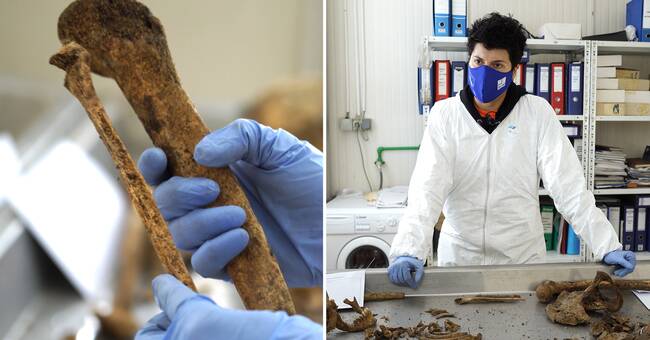In a makeshift elongated house in the Bosnian town of Tuzla, next door to a cemetery and a funeral home, one room is colder than the others.
There on floor-to-ceiling shelves are bags of remains from people whose families have missed them since the war in Yugoslavia in the early 1990s.
Here, the organization International Commission on Missing Persons (ICMP) works to give the remains a name.
Forensic scientist and anthropologist Dragana Vucetic is the first to try to understand who the person in front of her is.
Today, she works on skeletal parts found by chance by construction workers in Srebrenica, where more than 8,000 Bosniaks were murdered in July 1995.
- Here the radius is double, which means that this is at least two people.
Based on my previous experience, the radius is the only double.
The rest belong to one and the same person.
I can see that this is a man over 50 years old, she says about the remains in front of her.
Can be found in several graves
Cases from Srebrenica are complicated because the perpetrators dug up the first graves with bulldozers and buried the dead in other places, in an attempt to hide the crime.
The remains of a person can thus be found in several graves and be severely damaged.
To be able to identify them, they are DNA-tested and the profile is then run against a database with DNA from relatives.
It was only when they started using DNA at the turn of the year 2001-2002 that the number of successful identifications soared.
To date, more than 7,000 of the more than 8,000 murdered in Srebrenica have been identified, and about 70 percent of those missing after the war in total.
Javascript is disabled
Javascript must be turned on to play video
Read more about browser support
The browser is not supported
SVT does not support playback in your browser.
We therefore recommend that you switch to another browser.
Read more about browser support
The war in Yugoslavia Photo: Michel Euler / AP
The ICMP believes that the success is due to the fact that there was no clear winner after the conflict and no one could decide not to look for the missing.
Something that is unusual after a war.
Before having access to DNA, attempts were made to make matches using clothes and personal belongings found in the graves.
A catalog of jeans, shawls, sweaters, underwear, cutlery and other things was created for the family to look at. - It was not a great method.
The family did not always know what the person was wearing on the day they disappeared and many wore clothes they received from aid organizations, says Dragana Vucetic.
Photo: Tomas Wagner
Dragana Vucetic says she is proud of the work the ICMP has done.
Not only by giving families an opportunity to bury their relatives but also by gathering evidence of war crimes before the courts.
But she does not expect to find all the missing.
- In the last couple of years, we have not found a major mass grave.
The remains are in the forest and there are very modest amounts.
We have achieved fantastic results, but a thousand people are still somewhere.
See more about the ICMP's work to identify missing persons in the clip above.

